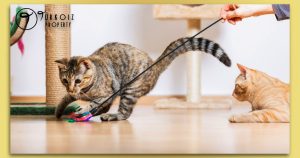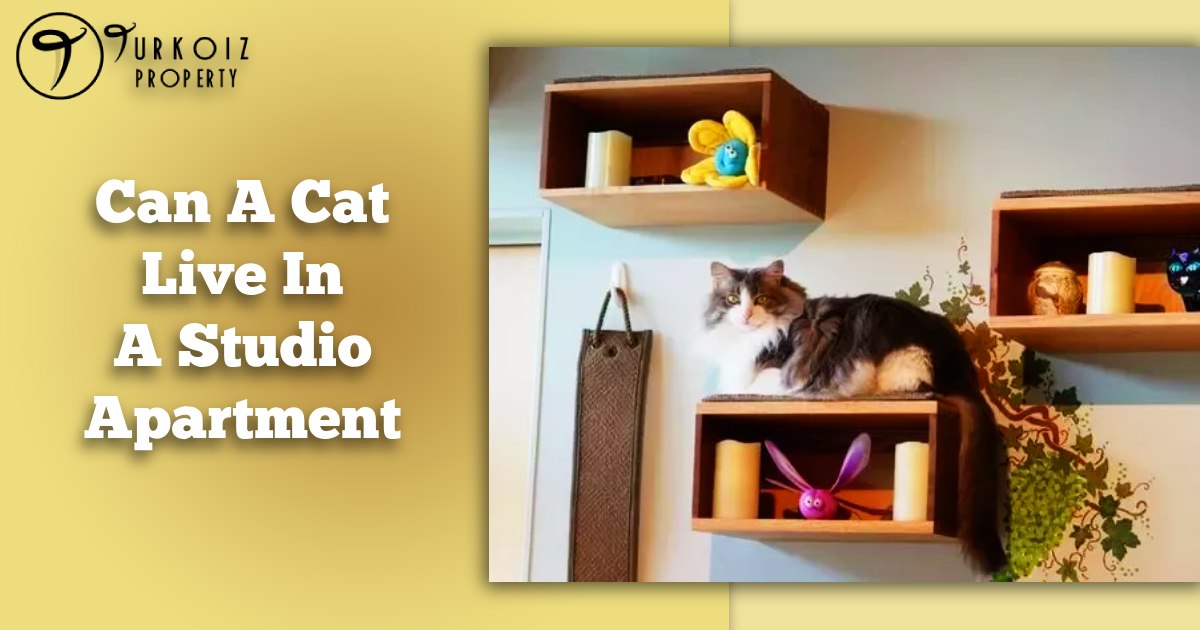As urbanization gains momentum, many people are considering studio apartments and cat care, seeking to balance compact living with pet companionship. Can a cat live in a studio apartment and be content?
As the notion of cats in small studio apartments gains traction, it’s crucial to evaluate both the benefits and considerations.
If you’ve been wondering whether cat-friendly studio apartment life is feasible, this article delves deep into providing the answers you seek.
Suitability of a Cat in a Studio Apartment

Cats, renowned for their independent nature, have a remarkable ability to adapt to their surroundings. This adaptability makes them suited for living in studio apartments. While dogs may require ample outdoor space, cats can thrive indoors, provided their needs are met. Nonetheless, when contemplating housing a cat in a compact studio, factors such as breed, age, and temperament play a vital role.
Benefits of Owning a Cat in a Studio Apartment
Cats thriving in limited studio space isn’t just beneficial for them, but for their owners too. Cats offer unconditional studio apartment cat companionship, becoming pillars of emotional support.
They require less space and are less dependent on outdoor activities. There’s also the undeniable stress relief that comes from watching a feline companion play or simply rest.
This blend of companionship and low maintenance makes studio apartment cat ownership enticing.
Preparing the Studio Apartment for a Cat
To ensure coexisting with a cat in studio living is harmonious, you must prepare your space meticulously.
Creating Vertical Space
In tight confines, vertical space becomes a cat’s playground. Consider incorporating cat shelves, trees, and perches. These additions not only enhance feline life in studio flats but also keep your cat physically active.
Providing Entertainment
For a cat, a toy isn’t just for fun; it’s mental stimulation. From interactive toys to puzzle feeders, ensuring your cat remains engaged is key for their well-being.
Arranging Hideouts
Every cat yearns for its cozy corner. Whether it’s a plush cat bed or a quiet nook, ensuring they have hideouts is essential for their comfort and security.
Litter Box Placement
An often overlooked aspect of studio apartment and cat care is litter box placement. Finding a discreet yet accessible location is paramount, ensuring cleanliness and comfort.
Maintaining a Healthy Environment
Caring for a feline friend, especially in a confined space like a studio apartment, requires meticulous attention to their health and surroundings.
Grooming
Regular grooming isn’t just about aesthetics. It helps keep their coat free from mats, reduces hairballs, and allows you to check for any skin conditions or abnormalities.
Health Checks
Indoor cats aren’t immune to health concerns. Regular vet visits, vaccinations, and routine check-ups ensure your feline remains in top shape. Also, look for signs of lethargy, unusual behavior, or changes in appetite; these can indicate underlying issues.
Balanced Diet
Cats require a diet rich in protein. Ensure you’re feeding them high-quality cat food that meets their age and health requirements. Remember to avoid overfeeding, as a sedentary indoor lifestyle can lead to obesity.
Pristine Environment
Cleanliness is paramount, particularly in a cat-friendly studio apartment life. Regularly clean their litter box, avoid clutter, and ensure the apartment is well-ventilated to minimize potential allergens.
Socialization and Playtime
The close quarters of a studio apartment can actually serve as a blessing in disguise when it comes to bonding with your cat.
Playtime

Dedicate a specific time each day for interactive play. Use toys like feather wands, laser pointers, or even a simple ball of yarn. This not only stimulates their mind but also ensures they get the physical activity they need.
Cuddling
Cats, though often seen as independent creatures, relish affection. Create a routine where you spend quiet moments just cuddling or petting your cat. This strengthens your bond and provides emotional comfort to your pet.
Training
Believe it or not, cats can be trained. Use positive reinforcement techniques to teach them simple tricks or commands. This keeps them mentally stimulated and reinforces your bond.
Addressing Potential Challenges
Even the most serene studio apartment isn’t without its challenges when it comes to cat ownership. Below are some potential challenges and how to address them:
Scratching
Cats have a natural inclination to scratch. This behavior, though normal, can become a challenge if they target your furniture. Address this by providing scratching posts or pads. Ensure they are strategically placed near their favorite scratching spots.
Restlessness
A confined space can sometimes lead to restlessness or zoomies in cats. Ensure you have dedicated play sessions and provide toys to combat this energy burst.
Territorial Behavior:
Cats are territorial creatures. If you’re considering introducing another pet or even a new person, do it gradually. Use scent swapping and slow introductions to minimize territorial disputes.
Litter Box Issues:
In small spaces, inappropriate elimination can become a problem. Ensure the litter box is clean, placed in a quiet location, and there are no underlying health issues causing this behavior.
By understanding and proactively addressing these challenges, coexisting with a cat in studio living becomes not just feasible, but enjoyable.
Discover Turkoiz Property: Your Gateway to Premium Living
When considering transitioning to a studio apartment lifestyle, choosing the right property is important.
Turkoiz Property is your trusted companion in this journey, offering a diverse range of premium apartments tailored to fit every lifestyle, including those with furry friends!
From spacious studios equipped for apartment living space for cats to larger units for families, Turkoiz Property understands the diverse needs of urban dwellers.
With an impeccable track record of quality properties and exceptional customer service, Turkoiz Property ensures that every tenant feels at home, whether you’re enjoying a sunset from your balcony or watching your cat frolic in its cozy corner.
Explore luxury and convenience with Turkoiz Property.
Creating a Cat-Friendly Studio Apartment
Urban living often means tight spaces, but that doesn’t mean you can’t create a cat haven right in your studio apartment.
Ensuring your apartment is comfortable, fun, and safe for your feline is essential to ensuring cats thrive in limited studio space.
DIY Cat-Friendly Furniture
Creating cat-friendly furniture not only saves you money but also allows you to tailor pieces to your apartment and your cat’s personality.
Cat Hammocks
With just some fabric and hooks, create a cozy hanging bed for your feline. Place it by a window, so your cat can bask in the sun and watch the world outside.
Repurposed Shelves
Turn any ordinary shelf into a cat perch. Add carpet or fabric for added comfort. Arrange them in a step-like manner, so your cat can jump from one level to the next.
Cardboard Playhouses
Instead of throwing away cardboard boxes, turn them into playhouses. Cut out doors and windows and stack them to make multi-level structures.
Maximizing Comfort in Small Spaces
When space is a premium, every square inch counts. It’s essential to ensure comfort without clutter.
Under Furniture Space
The space under your bed or couch can be an ideal hideout. Slide in a cozy blanket or a cat bed, and it’s the perfect spot for a catnap.
Window Sills
Enhance window sills with soft cushions. Cats love to perch there, watching the outside world.
Partitioned Spaces
Use room dividers to create partitioned areas for your cat. It can give them a sense of having their own territory within the apartment.
Ensuring Safety
With curiosity as a core trait, cats can sometimes end up in places they shouldn’t. Ensure safety with these tips.
Secure Window Screens
Cats love high places, but this can be dangerous if window screens aren’t secure. Always check them for sturdiness.
Hide Toxic Substances
Many houseplants and foods are toxic to cats. Always store food securely and research before bringing a new plant home.
Avoid Small Objects
Small items can be swallowed and cause choking hazards. Regularly sweep and declutter to avoid this risk.
By implementing these strategies and ideas, studio apartment cat companionship becomes a joy. The coexistence of cats and humans in small spaces proves that with a bit of creativity and love, size really doesn’t matter.
Conclusion
Balancing cat-friendly studio apartment life might seem daunting, but with preparation and understanding, it’s achievable. If you’re contemplating this lifestyle and wondering, “Can a cat live in a studio apartment?” remember that it’s all about meeting your cat’s needs. Interested in taking the plunge and providing a content home for your feline companion in a studio apartment?
I hope this article answered your question “Can a cat live in a studio apartment?”
